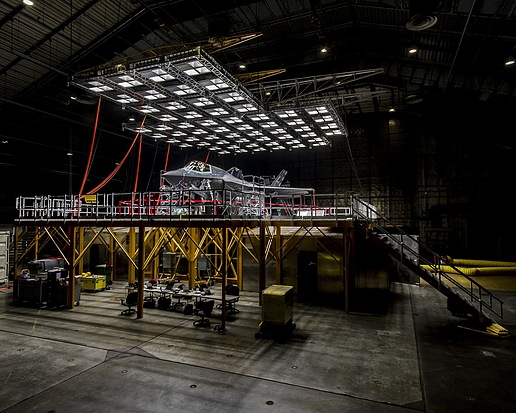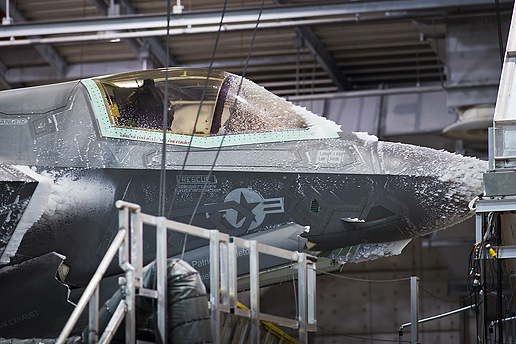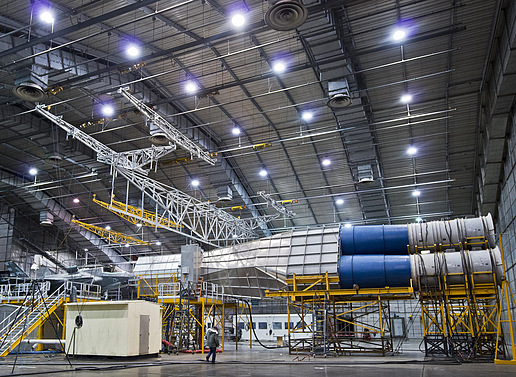 第96试验飞行中队麦金利天气实验室中,一架F-35正在承受冰冻天气的温度。飞机正在实验室中接受天气测试,以证明机队有能力在全球任何地方部署。
第96试验飞行中队麦金利天气实验室中,一架F-35正在承受冰冻天气的温度。飞机正在实验室中接受天气测试,以证明机队有能力在全球任何地方部署。 在冰冻天气中,当一架飞机以高速穿越云层时,飞机外侧将迅速聚集起大型冰块。厚重冰块可能发生断裂并伤害飞机,因此结冰是天气测试中最危险的元素之一。
在冰冻天气中,当一架飞机以高速穿越云层时,飞机外侧将迅速聚集起大型冰块。厚重冰块可能发生断裂并伤害飞机,因此结冰是天气测试中最危险的元素之一。 麦金利实验室中,一架F-35正在一台巨型太阳灯下接受极端测试。
麦金利实验室中,一架F-35正在一台巨型太阳灯下接受极端测试。 麦金利实验室中F-35承受的测试温度范围为-40°至+120°F,且该温度中任何可能遇到的气候条件都需得到测试。
麦金利实验室中F-35承受的测试温度范围为-40°至+120°F,且该温度中任何可能遇到的气候条件都需得到测试。 麦金利实验室已成为自1947年起研发的几乎所有飞机的天气测试中心。
麦金利实验室已成为自1947年起研发的几乎所有飞机的天气测试中心。
F-35为调试初始作战能力进行冷处理
位于弗洛里达州埃格林空军基地的第96试验飞行中队的麦金利气候实验室,从1947年开始成为一个重要的低温天气测试机构,至今已为各种飞机进行过相关测试。从B-29超级空中堡垒与P-51野马到洛克希德F-117、波音787以及空中客车A350 XWB,参与过测试的机型不胜枚举。
最近,来自马里兰州巴塔神河综合测试连队的一架洛克希德马丁F-35B在该实验室接受了严格的天气测试,以在其进行初始作战能力调试(IOC)的过程中,确保在各种气候条件下,性能水平得到万无一失的发挥。F-35B于2014年9月到达麦金利实验室,在接下来的6个月中,它将接受风、太阳辐射、雾、湿气、雨水浸入/倒灌、雨夹冰、冰冻云、结冰、涡流结冰与降雪等多种天气条件下的性能测试。
由于目前F-35项目涉及到13个国家,因此其将要飞行的所有国家的代表性天气都必须经过测试,其中包括澳大利亚南部的炎炎烈日,以及加拿大与挪威上空北极圈的刺骨严寒。
F-35将承受-40°到+120°F的测试温度范围,“以及该温度中的任何可能出现的天气情况,”在F-35上进行极冷测试操作的测试飞行员Billie Flynn表示。“它已经在100°F以上的高温和零下低温中飞行过了。在测试的最初几天,它将飞越冰冻天气和包括倾盆大雨和飓风在内的其他恶劣天气。我们每天都会多了解一些飞机的情况。”(点击此处观看Flynn谈论F-35天气测试项目的完整视频)
而实验舱可以进行“几乎所有天气条件的模拟,无论在普通还是垂直起飞模式下,飞机马力全开时可能遇到的所有天气条件,”麦金利天气实验室的技术人员Dwayne Bell表示。
由于F-35今年就要在美国海军陆战队开始IOC服役了,因此STOVL(短距起飞/垂直降落)测试将比之前的飞机在程序上多一些变化。埃格林空军基地报告称,F-35B的升力风扇系统需要设计一个用于“限制与支持”的结构,高度为12英尺,并与通风管系统结合在一起。这一装置使飞机实验室建筑内部也能用大马力运行,不论是使用普通模式还是STOVL模式。
为了给喷气口通风,以使舱内温度保持稳定,必须不断地泵送调节过的空气,以确保飞机内的压力永远高于发动机周围管道内的压力,并高于飞机其他开口处的压力。这一压差可确保喷射排气会通过管道流出舱外,从而使整个飞机维持在恒定的温度水平。
在数日的高温天气测试后,发动机的测试温度稳步上升至最高测试温度——120°F。实验舱内温度维持在预设温度上,同时飞机上方的太阳灯为飞机表面照上了强烈的日光。之所以这么做,是因为空气温度是不会在一天内保持不动的,它会随着太阳的升起温度升高,并在下午晚些时候达到最高点。而在实验舱内,工程师们创造了一天24小时的温度波动模拟条件。
在短短数日内,实验舱的环境就从亚利桑那州的酷暑转成了北极圈的严寒。麦金利实验室的制冷系统将室外空气冷却至极低温度,并将其推入舱内。当飞机结束测试时舱内温度已累积降至-40°F。在如此低的温度下,飞机系统中的液体开始变稠,各种机械的运行也开始变缓,这些都是测试工程师密切监控的重点。
在此之后,F-35需要迎战冰雪的猛烈攻击。在冰冻天气中,当一架飞机以高速穿越云层时,飞机外侧将迅速聚集起大型冰块。厚重冰块可能发生断裂并伤害飞机,进入发动机,或造成外物侵入的损害。因此,结冰是天气测试中最危险的元素之一。
一个由三个巨型圆柱体组成的大型装置以金字塔形堆叠起来,并与地面呈平行放置于F-35测试机体的前方。圆柱体内部安装了9个导管风扇,它们将一股巨大气流,吹入前方的一个漏斗内。漏斗前端安装的一个喷杆,能够产生由各种直径的小水滴组成的“云”。
这些小水滴朝着飞机的方向喷去,并在接触的同时冻结起来。尽管实验室不能产生飞机实际经历的精确风速,但实验舱内的这一独特装置却能够产生高达120 mph的恒定风速,这是F-35坠落时承受的速度。
冰雪测试可衡量飞机冰凌防护系统的有效性,以及飞机在冬季天气中的运行能力。
F-35 gets cold treatment in step toward IOC remedy
Since it first became an active cold-weather testing facility in 1947, the 96th Test Wing's McKinley Climatic Laboratory at Eglin Air Force Base, FL, there have been a wide variety of aircraft to undergo testing at the facility, ranging from the B-29 Superfortress and P-51 Mustang through to the Lockheed F-117, Boeing 787, andAirbus A350 XWB.
Most recently, one of Lockheed Martin’s F-35Bs from the F-35 Patuxent River Integrated Test Force in Maryland underwent rigorous climatic testing at the laboratory to verify its all-weather capabilities on its way toward Initial Operating Capability (IOC). The F-35B arrived at McKinley in September 2014, to begin a six-month assessment of the aircraft's performance in wind, solar radiation, fog, humidity, rain intrusion/ingestion, freezing rain, icing cloud, icing build-up, vortex icing, and snow.
With 13 countries currently involved with the program, the F-35 must be tested in all the meteorological conditions representative of those locations from which it will operate, ranging from the heat of northern Australia to the bitter cold of the Arctic Circle above Canada and Norway.
Testing for the F-35 can be done from -40° to +120°F “and every possible weather condition in between," said Billie Flynn, an F-35 test pilot who performed extreme cold testing on the aircraft. "It has flown in more than 100°F heat while also flying in bitter subzero temperatures. In its final days of testing, it will fly through ice and other conditions such as driving rain with hurricane force winds. We are learning more and more about the aircraft every day.” (Click here to view Flynn discussing the F-35 climatic test program.)
The chamber allows for the simulation of “virtually any weather condition—all while flying the jet at full power in either conventional or vertical takeoff mode," said Dwayne Bell, the McKinley Climatic Laboratory technical chief.
As the F-35 approaches its IOC debut for the U.S. Marine Corps this year, testing for the STOVL (short takeoff/vertical landing) variant required a few more adaptations to procedures than aircraft before it. Eglin AFB reports that the lift-fan system of the F-35B required the design of a 12-ft high “restraint and support” structure interwoven with a system of ventilation ducts. This apparatus secures the aircraft and allows it to operate at high power in both conventional and STOVL mode while inside the building.
To ventilate the exhaust and thus maintain a stable temperature inside the chamber, conditioned air is constantly pumped in to ensure the pressure in the building is always higher than the pressure inside the ducts surrounding the engine and other openings on the aircraft. This difference in pressure is a safeguard that maintains the jet exhaust is flowing out of the chamber through the ducts, allowing the facility to sustain a constant temperature.
Over days of high-temperature climatic testing, the temperatures of the engine runs were steadily and incrementally increased until it reached the test maximum of 120°F. While the chamber itself was set to a pre-determined temperature, additional solar lamps above the aircraft recreated the intense heat of the sun on the surface of the jet. This is done for the obvious reason that air temperature does not remain constant throughout the day—it increases each hour the sun is up, reaching its apex in the late afternoon. In the chamber, engineers recreated the temperature fluctuation of a 24-h day.
In a matter of days, the chamber transitioned from a seemingly Arizona sauna to the Arctic Circle. Outside air was super-cooled using McKinley Lab’s refrigeration system and pushed into the chamber. In increments, the chamber temperature fell to -40°F while the jet completed test runs along the way. At such frigid temperatures, aircraft fluids start to thicken and mechanisms operate slower—all points upon which test engineers monitor closely.
The F-35 then faced a harsh barrage of snow and ice. When an aircraft flies through clouds at high speeds in freezing climates, large pieces of ice can form quickly on the exterior. Heavy chunks of ice could potentially break off and damage the aircraft, errantly fly into the engine or create a foreign-object-damage concern. For this reason, icing is one of the most dangerous elements in climatic testing.
A large apparatus composed of three massive cylinders stacked in a pyramid, parallel to the ground, was placed in front of the F-35 test aircraft. Inside the cylinders were nine ducted fans that blew a large amount of air through a single funnel in the front. Attached to the front of this funnel was a spray bar capable of producing “clouds” of various water droplet sizes.
Those droplets were blown toward the plane and froze upon contact. While the lab cannot generate the precise wind speeds experienced by airborne aircraft, the unique setup inside the chamber is capable of producing sustained wind speeds up to 120 mph—all while subjecting the F-35 to precipitation.
Snow and ice testing gauges the effectiveness of the aircraft’s Ice Protection System and the ability of the jet to perform in winter weather.
等级
打分
- 2分
- 4分
- 6分
- 8分
- 10分
平均分
- 作者:admin
- 行业:航空
- 主题:噪声、振动与声振粗糙度质量、可靠性与耐久性运输系统车辆与性能测试与检验
